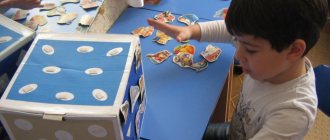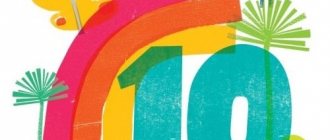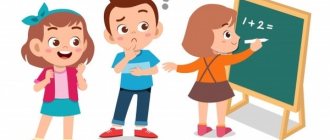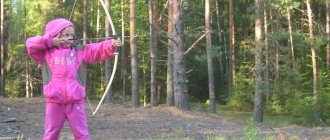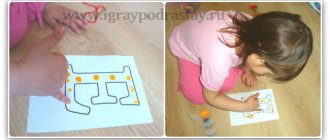- Why does a preschooler need to solve logic problems?
- Rules for solving logic problems for preschoolers
- Logic problems, assignments and games for preschoolers
Task for developing intelligence (for children aged 6, 7 years)
- Tasks for the development of creative abilities
- Logic problems - tests with answers
- Logic problems “Crossings and maneuvers”
- Entertaining tasks to develop logical thinking in preschoolers
The main and important point in the development of a preschooler is the formation of his logical thinking (this is precisely why it is necessary to solve logical problems!). Thanks to logic, you can explain life phenomena to a 5-6-7 year old child and justify your point of view. If you develop the ability to think and act logically in time, the child will definitely become a sane person.
To achieve this goal, parents and educators use various exciting and interesting games, create game situations of a logical nature, which makes classes not only interesting, but also very useful for small pets, as they are aimed at developing intelligence and thinking. Such tasks and games will force the little brain to reason, taking into account, first of all, logic.
We all know that children love to think, trying to show that they are adults. Yes, any adult will notice errors in reasoning, which are associated with an inaccurate logical structure of thought. The child very often reasons correctly and is close to the answer, but due to his lack of logic, it is difficult for him to explain or express his point of view. Adults will help him overcome this obstacle, and in this they will need logic games and tasks (tasks). When the baby finally gains the ability to think logically, he will easily be able to solve simple and complex problems that life will set for him.
Preschool children really like logic puzzles. They are interested in reasoning and flexing their brains. Many children, after reading a logical task, immediately give the correct answer, but not everyone can explain the course of their thoughts. Then the teacher or parent should help the student build a chain of thoughts using the correct methodology for working on tasks with a logical load.
Rules for solving logic problems for preschoolers
1. Spend up to 10 minutes exercising several times a week;
2. During the explanation, it is advisable to use visual materials (drawings, diagrams, tables);
3. Give the child a few minutes for his own reasoning, mandatory collective discussion, exchange of opinions;
4. You don’t have to write down tasks in your notebook;
5. When analyzing a logical problem, it is necessary to pay attention to the initiative and perseverance of students, help them find the answer thanks to correctly posed questions, and also explain beautiful and original solutions;
6. If the task turns out to be difficult, it is advisable to think at home.
Below are logic problems that are constantly used by teachers in their work, and most importantly, preschoolers readily solve them.
Finding errors and inconsistencies
These tasks are an excellent tool for training attention and it is not important that the child learns not to immediately take the information received on faith, but to think for a while.
For such tasks, you can use fable pictures (for non-speakers) or in the form of fable poems, for example:
- Sasha ate soup, so he is hungry;
- Ilona couldn’t come home, so she forgot her keys, etc.
By the way, such tasks are very useful for correcting agrammatisms and developing a full understanding of speech.
Logical tasks and games for preschoolers
Task for developing intelligence (for children aged 6, 7 years)
Among logic games, games for developing ingenuity occupy a significant place. They are lively, interesting, and you can learn a lot of new things from them. Such games allow the child to quickly switch from one activity to another, which helps develop logic. Games of wits help students win by showing their peers what they are capable of. Lazy kids, looking at the victory of others, should try to manifest themselves through trial and error, force themselves to think. Thus, logic games for developing ingenuity are very useful for the overall development of children. Examples of such games.
Game "That's how I am!"
Children form a circle. The presenter points to one of the students and says: “That’s how I am!” After this command, the student begins counting and the players count one by one, but earlier the leader said that instead of some numbers it is necessary to say “That’s how I am!” Such numbers can be numbers that contain the number 6, or numbers divisible by 2, etc. (for example: 1, 2, 3, 4, 5, “that’s how I am,” 7, 8, etc. ). You need to play fast. If a player gets lost, he leaves the game. The counting starts all over again. One player must remain.
Tasks for the development of creative abilities
Unfortunately, very often parents believe that it is impossible to develop logical thinking in a child, since he should have such abilities from birth. This is a wrong assumption. You should look closely at your baby, find hidden talents, and develop these talents from an early age. But in order to better achieve this goal, the child needs to create comfort and a good atmosphere.
Psychologists offer many games for developing creative abilities, in particular coloring books and exercises with completing pictures.
Game “Complete the picture”
Games and exercises to develop thinking in preschool children
2nd junior group (children 3 – 4 years old)
Game “In the garden, in the vegetable garden...”.
Goals: develop classification skills; help explore the order of things.
Game material and visual aids: cards with images of a vegetable garden, garden, forest; figures of vegetables, fruits, berries, mushrooms (cut out of cardboard).
Description: invite the child to correctly distribute the cut out figures, remembering what grows where: vegetables - in the garden, berries and mushrooms - in the forest, fruits - in the garden.
Game “What should we put in the refrigerator?”
Goals: develop classification skills; help explore the order of things.
Game material and visual aids: cards with images of a refrigerator, wardrobe, china cabinet, bookcase, images of objects stored in the refrigerator, wardrobe, etc.
Description: tell your child a story about how one boy decided to indulge himself: he took out all the food from the refrigerator, clothes from the closet, as well as all the dishes and books. All the things were mixed up, and he could not put them back in place, but the boy’s mother would see and be upset. “Let’s help the child and put everything in its place: food next to the refrigerator, clothes near the wardrobe, books near the bookcase, dishes in front of the cupboard.”
Game "Comparison of quantities."
Goal: to develop comparative analysis skills, speech, logical thinking.
Game material and visual aids: wide and narrow strips of paper, cubes.
Description: invite the child to build houses for the mouse and for the bunny: “Do you think we will build them houses of the same size?” Encourage the child to conclude that the mouse’s house should be smaller than the bunny’s house.
After the houses are ready, tell them that the animals asked to put paths in front of their houses for guests. But to prevent guests from getting confused, the path in front of the mouse house should be narrow, and in front of the hare house - wide. Show your child how to determine which of the tracks (paper strips) is wider by placing them on top of each other. Let the child himself distribute the paths between the houses.
Game "What is it like?"
Goal: develop comparison skills.
Description: invite your child to play questions and answers. For example: “What is as round as a ball?” (Watermelon, orange, apple, etc.); “What is as white as snow?”; "What's as sweet as sugar?" etc.
Game “The cow gives...”.
Goal: develop logical thinking through connections.
Game material and visual aids: cards with images of animals, products obtained from animals (milk, eggs, wool, etc.).
Description: Arrange the cards in random order. Invite the child, next to the image of each animal, to put an image of what this animal gives us. For example: chicken - egg, feathers (you can draw a pillow); cow - milk (cottage cheese, sour cream, kefir); goat - downy yarn (draw socks, mittens), etc.
Middle group (children 4 – 5 years old)
Game "Treasure Chest".
Goal: develop analysis skills.
Game material and visual aids: box (bag); any edible (inedible) thing that fits in a box (bag).
Description: ask your child to guess what’s inside using ten questions.
Game "Who was who?"
Goal: develop thinking.
Description: the child must name the state that preceded what the teacher calls him.
For example:
- Who was the old man? (As a boy.)
-What was the tree? (Rostkom.)
-What was Pinocchio? (With logs.)
Game "Guess by description."
Goals: develop thinking.
Description: Prepare riddle sentences in advance that children must answer.
For example:
• A beautiful insect with colorful wings, loves to fly, feeds on nectar. (Butterfly.)
• The transport is long, consists of several parts, runs on iron rails. (Train.)
• Wild animal, lives in the forest, howls at the moon. (Wolf.)
• A wild animal with red fur always deceives in fairy tales. (Fox.)
• Fruit with yellow skin. (Lemon.)
Game "Visual yes-no-ki".
Goals: teach to analyze; develop thinking.
Game material and visual aids: cards with images of objects (animals) or small toys.
Description: place toys or pictures (no more than 10) on the table, give the child a little time to look at them. Then ask: “What object did I wish for?” The child, using leading questions (Is it on the right half of the table? Below? Is it yellow? Is it heavy? Is it round?) identifies the hidden object (picture). To begin with, it is better for the teacher to act as the questioner. This way the child will understand the game script faster.
Game "Third Man".
Goal: to learn to classify objects according to the characteristics specified in the conditions.
Description: the teacher names three words, for example: “dog”, “cat”, “fish”. The child must determine: all three words refer to the designations of wildlife, but “dog” and “cat” designate animals, but “fish” does not. This means that the word fish is “superfluous”. Examples of words: birch, pine, rose; soap, shampoo, toothbrush; milk, kefir, tea.
Senior group (children 5 – 6 years old)
Game "Collect a flower".
Goal: to develop thinking, the ability to analyze and synthesize.
Game material and visual aids: cards depicting objects related to the same concept (clothing, animals, insects, etc.).
Description: each child is given a round card - the middle of the future flower (one - a dress, the second - an elephant, the third - a bee, etc.). Then the game is played in the same way as in lotto: the presenter distributes cards with images of various objects. Each participant must assemble a flower from cards, the petals of which depict objects related to the same concept (clothing, insect, etc.).
Game "Logical endings".
Goal: to develop logical thinking, imagination, ability to analyze.
Description: children are asked to complete the sentences:
• Lemon is sour, and sugar... (sweet).
• You walk with your feet, but throw... (with your hands).
• If the table is higher than the chair, then the chair... (below the table).
• If two are more than one, then one... (less than two).
• If Sasha left the house before Seryozha, then Seryozha... (left later than Sasha).
• If the river is deeper than a stream, then the stream... (smaller than a river).
• If the sister is older than the brother, then the brother... (younger than the sister).
• If the right hand is on the right, then the left hand... (on the left).
• Boys grow up to become men, and girls... (women).
Game "Ornament".
Goal: to develop logical thinking and the ability to analyze.
Game material and visual aids: 4-5 groups of geometric shapes (triangles, squares, rectangles, etc.), cut out of colored cardboard (figures of one group are divided into subgroups differing in color and size).
Description: invite the child to consider how you can create ornaments from geometric shapes on a playing field (sheet of cardboard). Then lay out the ornament (according to a model, according to your own plan, under dictation), using concepts such as “right”, “left”, “above”, “below”.
Game "Helpful - Harmful."
Goal: to develop thinking, imagination, ability to analyze.
Description: consider any object or phenomenon, noting its positive and negative sides, for example: if it rains, this is good, because plants drink water and grow better, but if it rains for too long, this is bad, because plant roots can rot from excess moisture.
Game "Everything that flies."
Goal: develop logical thinking.
Game material and visual aids: several pictures with various objects.
Description: invite the child to select the proposed pictures based on the named characteristic. For example: everything is round or everything is warm, or everything is animate that can fly, etc.
Game "What is it made of"
Goals: develop logical thinking; consolidate the ability to determine what material an object is made of.
Description: the teacher names some material, and the child must list everything that can be made from it. For example: tree. (You can use it to make paper, boards, furniture, toys, dishes, pencils.)
Preparatory group (children 6 – 7 years old)
Game “I take it with me on the road.”
Goal: develop logical thinking.
Game material and visual aids: pictures with images of single objects.
Description: Place images face down. Invite your child to go on a sea voyage. But in order for the trip to be successful, you need to thoroughly prepare for it and stock up on everything you need. Ask your child to take one picture at a time and talk about how this item can be useful. The objects in the pictures should be very different. For example, a child takes out a picture of a ball: “The ball can be played while resting, the ball can be used instead of a lifebuoy because it does not sink, etc.” You can play out various situations: on a desert island, on a train, in a village.
Game “How are they similar and how are they different?”
Goal: develop logical thinking.
Description: the presenter offers the children two objects, the children must compare them and indicate the similarities and differences. For example: plum and peach; little girl and doll; bird and plane; cat and squirrel; an orange and an orange ball of the same size; felt-tip pen and chalk.
Game "Resettlement of birds".
Goal: develop logical thinking.
Game material and visual aids: 20 cards depicting birds: domestic, migratory, wintering, songbirds, birds of prey, etc.
Description: invite the child to place the birds in nests: in one nest - migratory birds, in another - all those who have white plumage, in the third - all birds with long beaks. Which birds were left without a nest? What birds can be placed in several nests?
Game "Associations".
Goal: develop logical thinking.
Description: children are divided into two groups. One group invites the other to talk about an object, using words denoting other objects in their story. For example, talk about carrots using the words: duck, orange, cube, Snow Maiden. (It is the same color as an orange. It can be cut into cubes. Ducks love the top part of it. If you don’t eat it, you will be as pale as the Snow Maiden.) Then the groups change roles. The subject to be described and the words-characteristics are set by the presenter.
Game "Come up with a proposal."
Goals: develop logical thinking, speech activity; develop a sense of language.
Game material and visual aids: ping pong ball.
Description: the teacher sits with the children in a circle and explains the rules of the game. He says some words, and the children come up with a sentence using this word. For example: the teacher calls the word “close” and passes the ball to the child. He takes the ball and quickly answers: “I live close to the kindergarten.” Then the child says his word and passes the ball to the person sitting next to him. So, in turn, the ball passes from one player to another.
Assignments - tests (with answers) for children from 5 years old
Logical tasks also include tasks - tests. These tests contain one correct answer.
Task 1. Kolya, Anya and Nastya went into the forest and found 4 mushrooms. How many mushrooms would the children find if only Kolya and Anechka left?
a) 0; b) 1; at 2; d) 3; e) 4. (Correct answer.)
Solution. The number of mushrooms does not depend on the number of children who found them.
Problem 2. Alice had 3 ribbons. One of them was torn in half. How many ribbons does the girl have now?
a) 1; b) 3; at 4; (Correct answer.) d) 5.
Solution. Alice has two whole ribbons, and from one torn one two were formed. That is, the girl now has: 2 + 2 = 4 ribbons.
Task 3. Kostya wrote OLYA MALA on a piece of paper and went to the mirror. What phrase can you see in the mirror?
a) Olya small; b) SMALL OLIA; c) ALAM YALO; (correct answer.) d YALO ALAM.
Solution. Since all the letters of the written words are symmetrical, they will remain the same letters in the mirror. But they are located in the opposite direction. That is, two words are formed, written from the end. Experiment with paper in front of a mirror.
Problem 4. 8 children were playing in the yard. When mom called for lunch, Mariyka, Dima, Seryozha, Timofey, Uncle Nikolai and Grandfather Nikolai came running to the table from the yard. How many children are left playing in the yard?
a) 2; b) 3; at 5; d) 4. (Correct answer.)
Solution. Among all those who came running to their mother’s call, the children are Masha, Dima, Seryozha and Timofey, that is, four children came running. There are 8 – 4 = 4 children left to play in the yard.
Logic problems “Crossings and maneuvers”
Interesting logic problems are logical crossing problems and maneuvers. These exercises focus on difficult situations involving the crossing of animals or objects. It is necessary to come up with some way or algorithm to do this. They are usually called maneuvers. In crossing tasks, you need to transport something or someone or change places, observing some rules.
Problem 1. Two hungry dragons are resting on the left bank of the stream, and a defenseless kitten Vasya is sitting on the right bank of the stream. The Lord of the Dragons, Uncle Mitya, plies between the banks on his longboat. It is forbidden to leave a dragon and a kitten unattended on one of the banks, and more than one animal cannot be placed on a longboat. How can Uncle Mitya transport the dragons to the right bank and the kitten to the left?
Clue. First of all, the Lord of the Dragons, Uncle Mitya, must take one of the dragons with him.
Solution. To solve the problem, the lord of the dragons really first needs to take one of the dragons with him to the opposite shore, but there is a defenseless kitten sitting on the shore, therefore, having transported the dragon, Mitya will have to take the kitten with him to the opposite shore, on which there is still one dragon left. Uncle Mitya will take this dragon that remains with him and transport it to the right bank, and leave the kitten on the left bank. Thus, the lord of the dragons, Uncle Mitya, will transport the kitten to the left bank and the dragons to the right in three swims.
Problem 2. Two travelers approached the river. On the river bank a boat was found that could carry only one person. However, they were able to cross the river and continue their journey. How could this be?
Clue. Maybe they weren't walking together?
Solution. This is possible if they approached the river from different banks. Then the first crossed to the shore of the second, and the second to the shore of the first.
Task 3. The simplest maneuver exercise is to place three balls in the opposite direction. You can only change two adjacent ones.
The solution is very simple - change the balls one by one until you hold the desired one.
The proposed logic tasks are a good way to develop mathematical thinking and increase the activity of thought. With constant use of these, you can get high positive results in the development of logical thinking.
Entertaining tasks to develop logical thinking in preschoolers
A lot of tasks and logic games, as well as puzzles for children from 4 to 7 years old, can be found in the manual by Z.A. Mikhailova "Entertaining tasks for preschoolers."
The manual contains tasks, games, and puzzles for working with children aged 4-7 years. The material is presented in a certain system, which is important for increasing the level of general mental development of children, preparing them for mastering a mathematics course at school, and for creative work in the future.
An example of a logical problem from a book to find a pattern:
Problem with sticks (matches):
Download the manual in pdf format for free
Analogies and Antonyms
Analogies help to update your vocabulary and find logical connections between words:
- the fork is for eating, and the knife is for…(cutting);
- boots are shoes, and shorts are...(clothing);
- It’s cold in winter, and ... (warm) in summer, etc.
Antonyms:
- thick – thin;
- cold - warm;
- harmful - useful;
- evil - good, etc.
These words and phrases are given as an example; you can come up with something of your own, but you need to select them depending on the child’s individual level of knowledge.
Logic tasks to test the readiness of a 6-7 year old child for school
An excellent collection of logical tasks for preschoolers, developed taking into account the Federal State Educational Standard. In total, this book has five sections with logical tasks - comparison, classification, patterns, spatial thinking, and inference. Each section contains 7-11 exercises, which are best performed in the order in which they are given in the collection.
Download a collection of tests and logic problems for preschoolers in pdf format
Logic for children 5 - 7 years old
This manual contains very interesting tasks, assignments, exercises and games for the development of logical thinking in preschool children, aimed at comparing objects according to various criteria, highlighting significant differences between objects, generalization and classification. This book is recommended for use in kindergartens and at home for children to study together with their parents. This manual can be used to prepare for mathematics lessons at school.
Download the manual by Tikhomirova L.F. Logics. Children 5-7 years old in pdf format
Concept of logical thinking
Logical thinking is a physiological process as a result of which a person comes to conclusions based on evidence and prudence.
There are three types of logical judgments.
- Abstract judgment. A person builds conjectures on concepts and properties that cannot be felt. They are not valid, they are in the abstraction.
- Figurative judgment. A person uses his imagination and imagines specific images that occur in life.
- Verbal judgment. People often share their opinions with others. During the conversation, mental analysis occurs, leading to specific conclusions.
Logical thinking begins to develop at an early age. The stages of formation of thinking in the process of child growth will be discussed further.

